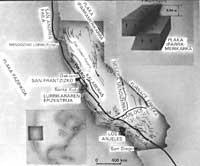Beno Gutenberg and Arthur Kennelly
1989/06/01 Azkune Mendia, Iñaki - Elhuyar Fundazioa Iturria: Elhuyar aldizkaria
Beno Gutenberg
Geologist born in Darmstadt (Germany) on June 4, 1889. He studied at the University of Göttingen, where he obtained his doctorate.
In 1930 he moved to the United States and in 1936 he obtained his citizenship.
He dealt with the internal composition of the Earth and he realized a theory explaining why seismic waves are not observed in a dark area. This area forms a layer around the Earth at a fixed distance from the epicenter of the earthquake.
In 1913 he suggested that the Earth had a core of 3,500 kilometers of radio in its center. There came seismic waves, refracting outside the dark zone. They also thought it was liquid because the waves did not enter the nucleus. Since then, analyzing the composition and density of the different meteorites, most geologists have accepted this theory and it is composed of iron and nickel (ratio 9/1).
The distance between the core and the mantle of the Earth is called the Gutenberg layer.
Gutenberg worked with Charles Richter on the consolidation of the Richter scale to measure the intensity of the earthquake, and between them published in 1941 the book entitled Seismology of the Earth. Gutenberg also has two books on earthquakes: The internal structure of the Earth (1939) and the American earthquakes (1951).
He worked as a professor of geophysics and director of the Seismological laboratory at the California Institute of Technology in Pasadena until his retirement in 1957. He died on January 25, 1960 in Los Angeles.
Arthur Edwin Kennelly
Electrical engineer born in Mumbai, India, December 17, 1861. As a young man he took care of electricity and worked as a telegrapher like Thomas Edison.
At the age of twenty he moved to North America, where he worked as an engineer accompanying Edison until 1894. Then J. Houston and both create an engineering office in Philadelpia on their own.
Kennelly's main contribution was not to invent new electrical appliances, but to apply advanced mathematics to electrical circuits. When he published his work Impedance, engineers began to use complex numbers in alternating current circuits.
In 1902, the previous year Guggenheim Marconi discovered his opinion on wireless transmission from Britain to America. Kennelly believes that radio waves passed from one continent to another following the straight line like light waves. To do this, radio waves were reflected in the ionized upper layer of the Earth's atmosphere. British physicist Oliver Heaviside, for his part and independently, explained the same theory a few months later, so it is called the Kennelly-Heaviside layer to which it reflects the waves in the ionosphere.
Engineer Kennelly died in Boston on June 18, 1939, more than fifty years ago.

Gai honi buruzko eduki gehiago
Elhuyarrek garatutako teknologia




